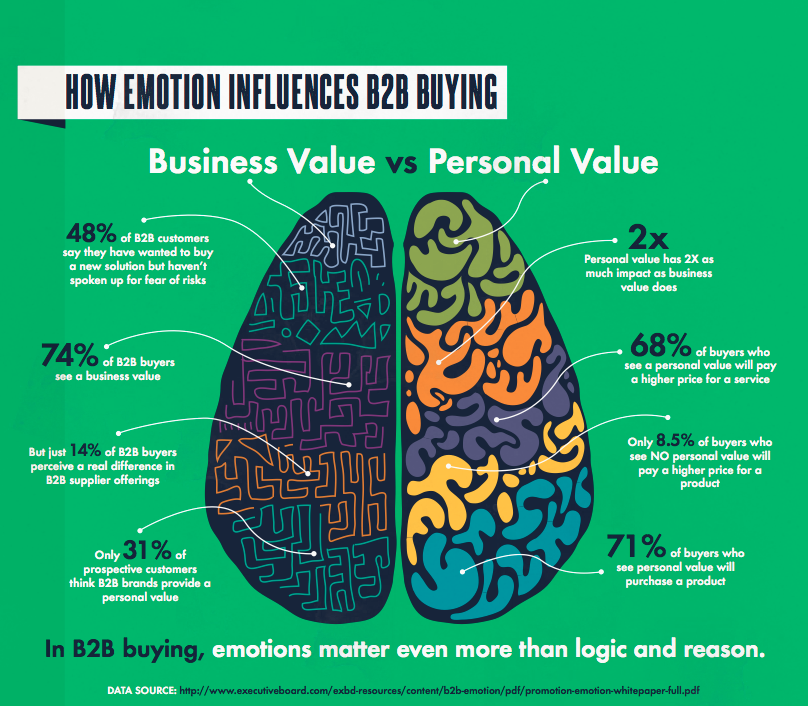Far too many B2B companies have blogs they’ve neglected, mismanaged, and left to rot. They go month after month without updates, and when a new post is finally published, no one reads it anyway.
So, management decides blogging isn’t even worth the effort. Don’t let that happen to you and your company’s blog!
A good blog can be a cornerstone of a powerful content marketing program, but only if you know how to do it right.
It seems so much easier to create content for a business-to-consumer company while business-to-business marketing seems like it is supposed to be dry and dull.
Here’s how some marketers assume the formula works:
B2C Content = Fun! B2B Content = Bored to death.
But, that’s just not true!
There’s no such thing as a boring topic, just boring content.
If you’re offering a product or service that solves problems and makes a difference, then you have an audience that will benefit from your blog.
If you have in-depth knowledge and experience on a subject, then blogging is the perfect opportunity to establish your company as a trusted industry expert.
Here are six ways to improve your content marketing with a better B2B blog.
1. Be Emotional
We know what you’re thinking …
Emotions? In business-to-business marketing? No way! Our customers are rational. They want logical proof. They want numbers. They want the facts and nothing but the facts!
The fact is, nothing could be further from the truth, and we have in-depth research to prove it.
The Think With Google piece, From Promotion to Emotion Connecting B2B Customers to Brands, details findings from a study by Motista. It surveyed 3,000 customers from three dozen brands across different industries, and the findings were surprising.
“Not only did the B2B brands drive more emotional connections than B2C brands, but they weren’t even close … On average, B2B customers are significantly more emotionally connected to their vendors and service providers than consumers.”
The study found B2C brands have an emotional connection of 10 to 40 percent, but the majority of B2B brands reviewed had an emotional connection of about 50 percent.
Why is that? It’s because of the relationship B2B customers have with the companies they choose to work with.
Think about it this way …
Most of the time, a shopper who has a bad experience with a particular brand or store can easily choose a different brand or head to the store down the street.
However, an experience with a B2B vendor could cost a company a lot of money or save them a ton of money. It could cost someone their job or lead to a big promotion. The stakes are higher, the risks are greater, and so are the potential rewards.
B2B purchasers are evaluating both the impact to the business and the personal value of their decisions. The infographic below from Kapost illustrates the way many B2B customers think.
The most important emotion in B2B content marketing is trust. The content you post on your blog should show why you should be trusted and how you alleviate a potential customer’s fears, solve their problems, and act as a valuable partner.
Your values and mission matter, too. B2B customers are always asking themselves, “Do people like me do business with companies like this?”
2. Use Data and Tell Stories
An emotional connection is important, but that doesn’t mean facts and figures are useless. The key is using numbers and research to tell a compelling story.
Good storytelling without solid proof is just fluff.
Lots of good data without a story is cold and boring.
Case studies are one type of content where data and stories form a perfect union. You have a real world example of how the product or service you provide created a solution. You may have numbers explaining the size of the project. You may have data showing how your efforts improved sales or reduced costs for your client. Use that data!
Yet, if you just write about facts and add a few charts and graphs, you’ve failed.
Case studies provide an excellent opportunity to tell a story because they give you a perfect three-act structure.
- Act 1 – The Setup: Explain the challenge that needs to be overcome.
- Use numbers and data to show how bad the problem is.
- Act 2 – The Process: Tell the story of what your company did to help.
- Use numbers and data to illustrate your efforts and scope of the project.
- Act 3: The Results: Wrap up with the “happy ending” your company provided.
- Use numbers as proof of the value you gave your client in the end.
The best kind of blogging connects right brain and left brain decision making. People use rational information to justify their emotional decisions.
3. Stop Talking About Yourself
Is your blog full of company news, awards, employee profiles, and a bunch of plain old bragging? That’s a classic B2B blogging mistake.
It’s like being the arrogant guy at the party who keeps talking about how awesome he is while never asking anyone else questions. Don’t be that guy!
Content marketing should be about your audience, not your company. Your blog posts should provide value by answering questions and giving important advice. It should celebrate the victories of your customers even as you highlight the work your company does.
You are Obi-Wan Kenobi. They are Luke Skywalker.
You are Morpheus. They are Neo.
You are Gandalf. They are Frodo.
You are Mickey Goldmill. They are Rocky Balboa.
You are Jack Donaghy. They are Liz Lemon.
What we’re saying is … be the mentor. Make your customer the hero.
Of course, there is a time and place for talking about yourself, too. That’s why we’ll often recommend separating blogging and public relations on our client’s websites. You’ll find a blog section as well as a newsroom with press releases.
4. Cut the Technical Jargon
An important part of understanding your audience is learning to speak their language. The level of technical expertise and the tone of voice you use depend on the type of people you’re trying to reach.
There’s a fine line between sounding like you’re talking down to your audience and going over their heads. Your content needs to hit that sweet spot in the middle.
A big part of online content marketing is education, which means you need to be able to teach your target audience about technical topics without using too much industry jargon.
It’s easy to fall into the trap of overusing industry terms. I just made the mistake of using jargon in the paragraph above. I used the marketing term “target audience,” but maybe I should have said “the people you want to reach.”
When in doubt, it’s best to over-explain rather than leave your readers scratching their heads. It will be much better for them to think “I already knew that” instead of leaving your site for a competitor who does a better job answering their questions.
Save the super technical stuff for specifications and manuals. When you’re writing for a blog, conversational writing is the right way to go.
5. Write a Lot, Write a Little
Should your content be concise and to-the-point or chock-full of as much information as possible?
The short answer is you need to create both. Now for the long answer …
The debate over long vs. short online content has been going on for years, and both sides have good arguments.
Short content is easy to consume. It works well in a world of short attention spans and busy schedules.
However, longer content tends to be seen as more authoritative by search engines like Google, and B2B customers preparing to make a major purchase may want as many details as possible.
The best advice is to write your blog content based on the audience you want to reach, the point they’re at in their path-to-purchase, and the goals you want that blog post to serve. Does the article cover a complex topic that you hope will convince a prospect to make a purchase, or is it a lighthearted branding piece you hope people will share on social media?
The post you’re reading is fairly long (thanks for making it this far). That’s because we’re trying to reach B2B companies that are getting serious about their content marketing efforts and aren’t looking for a quick fix.
Just remember, it’s not about how often you post to your blog, it’s not about how long or short your posts are, it’s about the quality of the content and the value you’re providing.
6. Make it More than Words
Your B2B blog can and should be more than just a bunch of text. The most effective content marketers are always thinking about what kinds of visuals they can add to their blog posts.
You could use stock photography, casual candid photos from your smartphone, or build a library of visual assets taken by a professional photographer. You can add charts and graphs, develop eye-catching infographics, or create custom illustrations.
Video is becoming increasingly important in online marketing, and the rise of podcasting is proof that audio content has its place as well.
There’s no reason why a piece of blog content shouldn’t include several different types of media on one page. Some people prefer to read, some to watch, some to listen. We all like learning in different ways.
A blog can be home to all sorts of content. Be creative with how you use it.
Content Marketing Starts with Strategy
Before you even begin blogging, you need to have a strategy. It’s an area where many B2B marketers fall short.
A 2016 Content Marketing Institute study of B2B companies found less than one-third of B2B marketers had a documented content marketing strategy.
This is one area where Element can help!
Companies participating in our content marketing programs get a complete strategy including things like an analysis of top competitors, target audience research, a social media audit, and a detailed plan for your website including a blog. We also focus on public relations, social media, and paid advertising efforts.
All of those different marketing channels are connected and need to work together. That’s why you need a B2B content marketing strategy.
Element’s team of marketing strategists, content creators, web developers, public relations experts, and graphic designers can help you develop a solid plan that boosts your online marketing efforts to new heights with quality content.
Ready to find out more? Contact us today and let’s see if your business is a good fit for a content marketing program!









